Posts Tagged omega 3
October 31, 2014 at 2:41 pm · Filed under RLS and Inflammation ·Tagged anti-inflammatory, aspartame, astaxanthin, caffeine, calcium, cayanne, chronic inflammation, curcumin, David Wimble, diet, dopamine, dopamine levels, Dr. Leonard Weinstock, Electromagnetic Fields, EMF, epigenetics, epigenome, ferritin, ferritin level, flora, food intolerance, gaba, ginger, glutamate, glutamine, gluten, Gut Microbiota, herbal remedies, herbs, Histamine Intolerance, histamines, homeopathy, inflammation, Inflammation and RLS, inflammation remedies, insomnia, iron, iron level, leaky gut, magnesium, microbiome, minerals, monosodium glutamate, msg, natural antihistamines, natural healing, natural medicine, nsaids, nutrution, omega 3, probiotics, restless arms, restless feet, restless leg syndrome, Restless Legs and Insomnia, restless legs cure, restless legs remedy, restless legs symptoms, restless legs syndrome, restless legs syndrome symptoms, rls, RLS and Epigenetics, RLS and Food Intolerance, RLS and Inflammation, RLS and Inflammation ·Tagged An ABSOLUTE Cure for RLS, rls cure, rls remedy, rls symptoms, salt, silent inflammation, sleep disorders, st. john's wort, sugar, systemic enyzmes, The Restless Legs Diet, vitamin b12, vitamin c, WED, willis-ekbom, willis-ekbom cure
“I have thoroughly analyzed every known scientific study that has been done on Restless Legs Syndrome. Taking all of this data into consideration, there is no doubt in my mind that inflammation plays a major role in the occurrence of RLS. I see this time and time again with many patient types.”
– Dr. Leonard Weinstock, MD, Specialist In Gastroenterology, St. Louis, MO

Permalink
October 29, 2014 at 4:37 pm · Filed under RLS and Inflammation ·Tagged anti-inflammatory, aspartame, astaxanthin, caffeine, calcium, cayanne, chronic inflammation, curcumin, David Wimble, diet, dopamine, dopamine levels, Dr. Leonard Weinstock, Electromagnetic Fields, EMF, epigenetics, epigenome, ferritin, ferritin level, flora, food intolerance, gaba, ginger, glutamate, glutamine, gluten, Gut Microbiota, herbal remedies, herbs, Histamine Intolerance, histamines, homeopathy, inflammation, Inflammation and RLS, inflammation remedies, insomnia, iron, iron level, leaky gut, magnesium, microbiome, minerals, monosodium glutamate, msg, natural antihistamines, natural healing, natural medicine, nsaids, nutrution, omega 3, probiotics, restless arms, restless feet, restless leg syndrome, Restless Legs and Insomnia, restless legs cure, restless legs remedy, restless legs symptoms, restless legs syndrome, restless legs syndrome symptoms, rls, RLS and Epigenetics, RLS and Food Intolerance, RLS and Inflammation, RLS and Inflammation ·Tagged An ABSOLUTE Cure for RLS, rls cure, rls remedy, rls symptoms, salt, silent inflammation, sleep disorders, st. john's wort, sugar, systemic enyzmes, The Restless Legs Diet, vitamin b12, vitamin c, WED, willis-ekbom, willis-ekbom cure
 In PART ONE of this article I listed how several inflammatory conditions have been tested to have a higher prevalence of Restless Legs Syndrome. Yet the idea of inflammation being the common link is completely ignored.
In PART ONE of this article I listed how several inflammatory conditions have been tested to have a higher prevalence of Restless Legs Syndrome. Yet the idea of inflammation being the common link is completely ignored.
As a medically uneducated person, if I was faced with a question on an exam that stated “There are forty inflammatory conditions that show a higher prevalence of Restless Legs Syndrome. Based on this information, what do you think may be causing the legs to be restless?”
a) abnormal use of iron by the brain
b) dopamine receptors are not signalling correctly
c) medications
d) inflammation
The dumb me would think, “well, if they’re all inflammatory conditions, I’m going to take a wild guess and say that the common link is d) inflammation.”
However, I would be wrong. In fact, according to science ALL the answers are right, except mine.
So despite my stifling ignorance, I present to you more evidence of the unshakeable link between inflammation and Restless Legs Syndrome.
Please visit The Healthy Elephant to read the rest of this article:
http://www.thehealthyelephant.com
Permalink
October 25, 2014 at 4:01 pm · Filed under ARTICLES by other authors ·Tagged anti-inflammatory, aspartame, astaxanthin, caffeine, calcium, cayanne, chronic inflammation, curcumin, David Wimble, diet, dopamine, dopamine levels, Dr. Leonard Weinstock, Electromagnetic Fields, EMF, epigenetics, epigenome, ferritin, ferritin level, flora, food intolerance, gaba, ginger, glutamate, glutamine, gluten, Gut Microbiota, herbal remedies, herbs, Histamine Intolerance, histamines, homeopathy, inflammation, Inflammation and RLS, inflammation remedies, insomnia, iron, iron level, leaky gut, magnesium, microbiome, minerals, monosodium glutamate, msg, natural antihistamines, natural healing, natural medicine, nsaids, nutrution, omega 3, probiotics, restless arms, restless feet, restless leg syndrome, Restless Legs and Insomnia, restless legs cure, restless legs remedy, restless legs symptoms, restless legs syndrome, restless legs syndrome symptoms, rls, RLS and Epigenetics, RLS and Food Intolerance, RLS and Inflammation, RLS and Inflammation ·Tagged An ABSOLUTE Cure for RLS, rls cure, rls remedy, rls symptoms, salt, silent inflammation, sleep disorders, st. john's wort, sugar, systemic enyzmes, The Restless Legs Diet, vitamin b12, vitamin c, WED, willis-ekbom, willis-ekbom cure
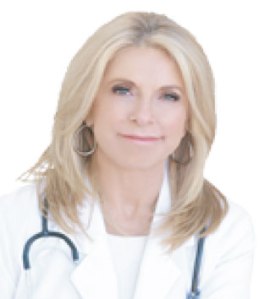 “Emotional well being is an integral part of a healthy physical body In conditions like Restless Legs Syndrome.
“Emotional well being is an integral part of a healthy physical body In conditions like Restless Legs Syndrome.
I ask my patients to look beyond the symptoms and consider what may be causing these issues in the context of their emotions. Are their legs trying to tell them something? Where are they experiencing emotional restlessness in their lives? It is important to take a step back and take an honest look at the bigger picture of inner well-being. It’s amazing what we can discover when we think about changes we need to make in our daily lives that may be contributing to physical symptoms from stress, or other emotional variables.
When we work with our body naturally, we can utilize safe and effective techniques such as nutritional supplementation to help correct some of the imbalances. Conditions like restless legs syndrome can significantly interrupt daily life, but we can work to figure out what our body needs, and provide that in a course of treatment. When we use our body’s own wisdom to heal, we can rest more than our legs, we can rest our minds and our spirits. And that is definitely worth the effort.”
Marcelle Pick, OB/GYN and Pediatric NP grew up in Australia, surrounded by aboriginal cave drawings, healthy home-cooked meals, sunshine and beautiful crystal water. It was there that she gained an appreciation for the healing power of nature, whole foods, and positive thinking.
After earning a BS in Nursing from the University of New Hampshire School of Nursing, a BA in Psychology from the University of New Hampshire, and her MS in Nursing from Boston College–Harvard Medical School, Marcelle went on to co-found the world-renowned Women to Women Clinic in Yarmouth, Maine, with a vision to change the way in which women’s health care is delivered. In her practice, Marcelle undertakes an integrative approach that not only treats illness, but also helps women make choices to prevent disease. She has successfully worked with thousands of women to help them create wellness in their lives. http://www.marcellepick.com
Permalink
October 23, 2014 at 8:17 pm · Filed under RLS and Inflammation ·Tagged anti-inflammatory, aspartame, astaxanthin, caffeine, calcium, cayanne, chronic inflammation, curcumin, David Wimble, diet, dopamine, dopamine levels, Dr. Leonard Weinstock, Electromagnetic Fields, EMF, epigenetics, epigenome, ferritin, ferritin level, flora, food intolerance, gaba, ginger, glutamate, glutamine, gluten, Gut Microbiota, herbal remedies, herbs, Histamine Intolerance, histamines, homeopathy, inflammation, Inflammation and RLS, inflammation remedies, insomnia, iron, iron level, leaky gut, magnesium, microbiome, minerals, monosodium glutamate, msg, natural antihistamines, natural healing, natural medicine, nsaids, nutrution, omega 3, probiotics, restless arms, restless feet, restless leg syndrome, Restless Legs and Insomnia, restless legs cure, restless legs remedy, restless legs symptoms, restless legs syndrome, restless legs syndrome symptoms, rls, RLS and Epigenetics, RLS and Food Intolerance, RLS and Inflammation, RLS and Inflammation ·Tagged An ABSOLUTE Cure for RLS, rls cure, rls remedy, rls symptoms, salt, silent inflammation, sleep disorders, st. john's wort, sugar, systemic enyzmes, The Restless Legs Diet, vitamin b12, vitamin c, WED, willis-ekbom, willis-ekbom cure
 A very special thanks to Laurie Boucino of “The Healthy Elephant” for publishing my article about RLS and inflammation.
A very special thanks to Laurie Boucino of “The Healthy Elephant” for publishing my article about RLS and inflammation.
In this article I’ve taken all the evidence I’ve compiled from researching scientific studies and packed it into a single article. It will hopefully sway even the most devote skeptic.  You can view PART ONE of the article at the Healthy Elephant website ww.thehealthyelephant.com
You can view PART ONE of the article at the Healthy Elephant website ww.thehealthyelephant.com
The Healthy Elephant website was created in order to guide people to wellness and personal healthcare empowerment through education.
Permalink
October 22, 2014 at 6:25 am · Filed under RLS Success Stories ·Tagged anti-inflammatory, aspartame, astaxanthin, caffeine, calcium, cayanne, chronic inflammation, curcumin, David Wimble, diet, dopamine, dopamine levels, Dr. Leonard Weinstock, Electromagnetic Fields, EMF, epigenetics, epigenome, ferritin, ferritin level, flora, food intolerance, gaba, ginger, glutamate, glutamine, gluten, Gut Microbiota, herbal remedies, herbs, Histamine Intolerance, histamines, homeopathy, inflammation, Inflammation and RLS, inflammation remedies, insomnia, iron, iron level, leaky gut, magnesium, microbiome, minerals, monosodium glutamate, msg, natural antihistamines, natural healing, natural medicine, nsaids, nutrution, omega 3, probiotics, restless arms, restless feet, restless leg syndrome, Restless Legs and Insomnia, restless legs cure, restless legs remedy, restless legs symptoms, restless legs syndrome, restless legs syndrome symptoms, rls, RLS and Epigenetics, RLS and Food Intolerance, RLS and Inflammation, RLS and Inflammation ·Tagged An ABSOLUTE Cure for RLS, rls cure, rls remedy, rls symptoms, salt, silent inflammation, sleep disorders, st. john's wort, sugar, systemic enyzmes, The Restless Legs Diet, vitamin b12, vitamin c, WED, willis-ekbom, willis-ekbom cure
 Jean Alvisse is a personal trainer at Innervate Health & Fitness in Sydney Australia. She sent me the following:
Jean Alvisse is a personal trainer at Innervate Health & Fitness in Sydney Australia. She sent me the following:
“I just wanted to share this news.
I have suffered from RLS for over 20 years. About 3 months ago the RLS had reached a point that was unbearable. We had our first baby so sleep was limited already. With the RLS peaking in intensity it honestly had me questioning my sanity.
I have never taken any prescribed drugs for the RLS but because my legs were so debilitating I arranged to see my doctor.
Literally the night before my appointment in my sleepless and defeated state I was on the internet and stumbled upon the www.rlcure.com website.
I started with the herbs, vitamins and supplements and the elimination diet immediately.
The first 3 days were still awful, then by the 4th day the intensity was beginning to lessen. By the 8th day I was sleeping the whole night through!
For me, eggplant, spinach and mushrooms are my enemy.
I am so grateful. My sanity levels have been restored. I have enjoyed over 2.5 months of peaceful legs and wonderful sleeps.
However if I am very stressed or overtired the RLS does surface but the intensity is manageable.
Thank you again I am eternally grateful!”
– Jean Alvisse, Sydney Australia
Permalink
October 21, 2014 at 2:01 am · Filed under Testimonials ·Tagged anti-inflammatory, aspartame, astaxanthin, caffeine, calcium, cayanne, chronic inflammation, curcumin, David Wimble, diet, dopamine, dopamine levels, Dr. Leonard Weinstock, Electromagnetic Fields, EMF, epigenetics, epigenome, ferritin, ferritin level, flora, food intolerance, gaba, ginger, glutamate, glutamine, gluten, Gut Microbiota, herbal remedies, herbs, Histamine Intolerance, histamines, homeopathy, inflammation, Inflammation and RLS, inflammation remedies, insomnia, iron, iron level, leaky gut, magnesium, microbiome, minerals, monosodium glutamate, msg, natural antihistamines, natural healing, natural medicine, nsaids, nutrution, omega 3, probiotics, restless arms, restless feet, restless leg syndrome, Restless Legs and Insomnia, restless legs cure, restless legs remedy, restless legs symptoms, restless legs syndrome, restless legs syndrome symptoms, rls, RLS and Epigenetics, RLS and Food Intolerance, RLS and Inflammation, RLS and Inflammation ·Tagged An ABSOLUTE Cure for RLS, rls cure, rls remedy, rls symptoms, salt, silent inflammation, sleep disorders, st. john's wort, sugar, systemic enyzmes, The Restless Legs Diet, vitamin b12, vitamin c, WED, willis-ekbom, willis-ekbom cure
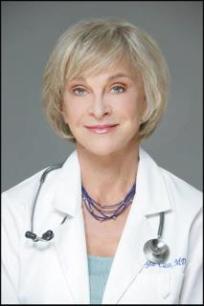 I’d like to give a heart-felt thank you to Dr. Hyla Cass, MD for promoting my website on her Facebook page http://www.facebook.com/hylacassmd
I’d like to give a heart-felt thank you to Dr. Hyla Cass, MD for promoting my website on her Facebook page http://www.facebook.com/hylacassmd
Dr Cass is a frequently quoted expert in the field of integrative medicine, addiction, women’s health, and psychiatry, combining the best of leading-edge natural medicine with the modern science, in her clinical practice, writings, lectures, and nationwide media appearances. She consults to the supplement industry on formulation, and is the author of numerous articles and several popular books including “Supplement Your Prescription”, “Natural Highs”, and “8 Weeks to Vibrant Health.”
You can find out more about Dr. Cass and her books at: http://www.cassmd.com
Permalink
October 17, 2014 at 3:29 am · Filed under ARTICLES by other authors ·Tagged anti-inflammatory, aspartame, astaxanthin, caffeine, calcium, cayanne, chronic inflammation, curcumin, David Wimble, diet, dopamine, dopamine levels, Dr. Leonard Weinstock, Electromagnetic Fields, EMF, epigenetics, epigenome, ferritin, ferritin level, flora, food intolerance, gaba, ginger, glutamate, glutamine, gluten, Gut Microbiota, herbal remedies, herbs, Histamine Intolerance, histamines, homeopathy, inflammation, Inflammation and RLS, inflammation remedies, insomnia, iron, iron level, leaky gut, magnesium, microbiome, minerals, monosodium glutamate, msg, natural antihistamines, natural healing, natural medicine, nsaids, nutrution, omega 3, probiotics, restless arms, restless feet, restless leg syndrome, Restless Legs and Insomnia, restless legs cure, restless legs remedy, restless legs symptoms, restless legs syndrome, restless legs syndrome symptoms, rls, RLS and Epigenetics, RLS and Food Intolerance, RLS and Inflammation, RLS and Inflammation ·Tagged An ABSOLUTE Cure for RLS, rls cure, rls remedy, rls symptoms, salt, silent inflammation, sleep disorders, st. john's wort, sugar, systemic enyzmes, The Restless Legs Diet, vitamin b12, vitamin c, WED, willis-ekbom, willis-ekbom cure
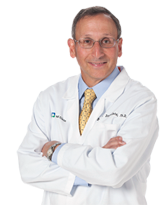 If you read health sites or follow celebrity doctors, you’ve probably heard the buzzword “inflammation.” You may even have heard people touting miracle cures such as the “anti-inflammatory diet.”
If you read health sites or follow celebrity doctors, you’ve probably heard the buzzword “inflammation.” You may even have heard people touting miracle cures such as the “anti-inflammatory diet.”
ARE YOU CONFUSED?
Many people think of inflammation in terms of external signs: swelling, bruising and so on. But in truth, uncontrolled inflammation plays a role in almost every major disease, including cancer, heart disease, diabetes, Alzheimer’s disease and even depression.
Inflammation occurs naturally in your body. But when it goes wrong or goes on too long, it can trigger disease processes. That’s why researchers spend so much time trying to understand it – and developing ways to counteract it.
“Inflammation occurs naturally in your body. But when it goes wrong or goes on too long, it can trigger disease processes.”
TOO MUCH OF A GOOD THING
Inflammation is your body’s first line of defense against toxins, infections and injuries.
When your cells are in distress, they release chemicals to alert the immune system. The immune system sends its first responders — inflammatory cells — to trap the offending substance or heal the tissue. As this complex chain of events unfolds, blood vessels leak fluid into the site of the injury, causing the telltale swelling, redness and pain. These symptoms might be uncomfortable, but they are essential for the healing process.
Here’s the problem with inflammation: Over time, you can end up with too much of a good thing. With chronic inflammation, your body is on high alert all the time.
This prolonged state of emergency can cause lasting damage to your heart, brain and other organs. For example, when inflammatory cells hang around too long in blood vessels, they promote the buildup of dangerous plaque. The body sees this plaque as foreign and sends more of its first responders. As the plaque continues to build, the arteries can thicken, making a heart attack or stroke much more likely.
Similarly, inflammation in the brain may play a role in Alzheimer’s disease. For many years the brain was thought to be off-limits to inflammation because of the blood-brain barrier — a sort of built-in security system — but scientists have proved that immune cells can and do infiltrate the brain during times of distress. Their role in disease progression is not yet clear, however.
WHY RESEARCHERS FOCUS ON INFLAMMATION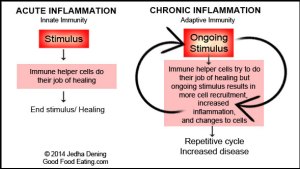
Add these disease processes — and many others — together, and it’s easy to understand why inflammation is a hot research topic. Understanding exactly how it causes disease could lead to better interventions and treatments to stop it.
The science of obesity offers an example. We’re learning more about how obesity triggers a cascade of inflammation that leads to metabolic conditions such as insulin resistance. Understanding exactly how that cascade works could lead to treatments for such conditions.
For example, Xiaoxia Li, PhD, of the Lerner Research Institute recently discovered that a protein called MyD88 helps coordinate the inflammatory cascade in obesity. Dr. Li’s research showed that making changes to MyD88 could reduce inflammation and insulin resistance in mice fed a high-fat diet. Future research to back up these findings could lead to better understanding, and even targeted therapy.
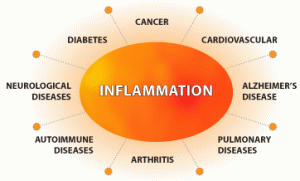 WHAT YOU CAN DO NOW
WHAT YOU CAN DO NOW
You’re going to have occasional inflammation from minor infections, allergies or injuries. This is normal. And every bump and bruise does not require an anti-inflammatory medication.
However, you can focus on lifestyle choices that reduce your risk of chronic inflammation — the kind that leads to disease. Many lifestyle factors have been shown to play a part in cellular inflammation: smoking, obesity, chronic stress and drinking alcohol excessively, for example. Fortunately, you can control these factors. And if you need help from a medical professional to do so, it’s available.
Work on a smoking cessation plan with your doctor, and know that many people need multiple attempts to find success quitting tobacco. Ask about a weight-loss plan through healthier diet and exercise, and know that medications and surgical options are available for more serious cases. Be wary of miracle claims about diets, but do seek nutrition advice from your doctor and a registered dietitian if needed. Talk to your doctor about stress-management techniques if work or home life are overwhelming you.

Researchers are learning more about the missing links between inflammation and disease every day. But until we have more answers, your best defense against inflammation is to control the factors you can choose to control.
As Chair of the Lerner Research Institute, Paul DiCorleto, PhD, oversees all laboratory and clinical research at Cleveland Clinic. He is an expert in cardiovascular biology.
Permalink
October 12, 2014 at 6:38 pm · Filed under RLS Success Stories ·Tagged anti-inflammatory, aspartame, astaxanthin, caffeine, calcium, cayanne, chronic inflammation, curcumin, David Wimble, diet, dopamine, dopamine levels, Dr. Leonard Weinstock, Electromagnetic Fields, EMF, epigenetics, epigenome, ferritin, ferritin level, flora, food intolerance, gaba, ginger, glutamate, glutamine, gluten, Gut Microbiota, herbal remedies, herbs, Histamine Intolerance, histamines, homeopathy, inflammation, Inflammation and RLS, inflammation remedies, insomnia, iron, iron level, leaky gut, magnesium, microbiome, minerals, monosodium glutamate, msg, natural antihistamines, natural healing, natural medicine, nsaids, nutrution, omega 3, probiotics, restless arms, restless feet, restless leg syndrome, Restless Legs and Insomnia, restless legs cure, restless legs remedy, restless legs symptoms, restless legs syndrome, restless legs syndrome symptoms, rls, RLS and Epigenetics, RLS and Food Intolerance, RLS and Inflammation, RLS and Inflammation ·Tagged An ABSOLUTE Cure for RLS, rls cure, rls remedy, rls symptoms, salt, silent inflammation, sleep disorders, st. john's wort, sugar, systemic enyzmes, The Restless Legs Diet, vitamin b12, vitamin c, WED, willis-ekbom, willis-ekbom cure
 “I had multiple symptoms including: RLS, rosacea, ocular rosacea, acne, depression, generalized pain, brain fog, fatigue after eating, phlegm, mushy stool.
“I had multiple symptoms including: RLS, rosacea, ocular rosacea, acne, depression, generalized pain, brain fog, fatigue after eating, phlegm, mushy stool.
These symptoms worsened after shoulder surgery.
I gave up gluten and experienced relief from my RLS. I took out all grains. I then discovered the Paleo diet – once again it helped enormously.
I switched to a similar diet called the Specific Carbohydrate Diet – with some improvement. http://scdlifestyle.com/about-the-scd-diet
During this time I had to supplement with Gabepentin but I could see I would need a higher dose soon and I did not want that.
I am now off all medication and this is what did it. No dairy, no soy, no grains, no sugar except honey, no potatoes, no additives, no caffeine, no alcohol except for dry “organic” wine.
I turns out that I needed a combination of the Specific Carbohydrate Diet and the Paleo Diet.
Good luck everybody!”
Permalink
October 10, 2014 at 6:25 pm · Filed under RLS and Inflammation ·Tagged anti-inflammatory, aspartame, astaxanthin, caffeine, calcium, cayanne, chronic inflammation, curcumin, David Wimble, diet, dopamine, dopamine levels, Dr. Leonard Weinstock, Electromagnetic Fields, EMF, epigenetics, epigenome, ferritin, ferritin level, flora, food intolerance, gaba, ginger, glutamate, glutamine, gluten, Gut Microbiota, herbal remedies, herbs, Histamine Intolerance, histamines, homeopathy, inflammation, Inflammation and RLS, inflammation remedies, insomnia, iron, iron level, leaky gut, magnesium, microbiome, minerals, monosodium glutamate, msg, natural antihistamines, natural healing, natural medicine, nsaids, nutrution, omega 3, probiotics, restless arms, restless feet, restless leg syndrome, Restless Legs and Insomnia, restless legs cure, restless legs remedy, restless legs symptoms, restless legs syndrome, restless legs syndrome symptoms, rls, RLS and Epigenetics, RLS and Food Intolerance, RLS and Inflammation, RLS and Inflammation ·Tagged An ABSOLUTE Cure for RLS, rls cure, rls remedy, rls symptoms, salt, silent inflammation, sleep disorders, st. john's wort, sugar, systemic enyzmes, The Restless Legs Diet, vitamin b12, vitamin c, WED, willis-ekbom, willis-ekbom cure
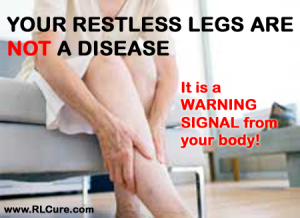 I’m going to keep repeating this mantra for as long as it takes because it’s CRUCIAL for people suffering from RLS to understand that the twitching and rustling of their legs is a SYMPTOM of a DEEPER issue that needs to be addressed.
I’m going to keep repeating this mantra for as long as it takes because it’s CRUCIAL for people suffering from RLS to understand that the twitching and rustling of their legs is a SYMPTOM of a DEEPER issue that needs to be addressed.
That issue being the presence of chronic inflammation
If the inflammation is not attended to, it will eventually manifest as a REAL disease or condition, one that is CERTAIN to affect your quality of life.
You don’t have to disobey your doctor. You can change your diet and add in some vitamins and supplements and still take your RLS and sleep medications. So, there’s no downside in making these changes.
For more information please visit this link:
http://www.rlcure.com/restless-legs-syndrome-willis-ekbom-is-not-a-disease.html
Permalink
October 8, 2014 at 11:16 am · Filed under An ABSOLUTE Cure for RLS, RLS and Inflammation ·Tagged anti-inflammatory, aspartame, astaxanthin, caffeine, calcium, cayanne, chronic inflammation, curcumin, David Wimble, diet, dopamine, dopamine levels, Dr. Leonard Weinstock, Electromagnetic Fields, EMF, epigenetics, epigenome, ferritin, ferritin level, flora, food intolerance, gaba, ginger, glutamate, glutamine, gluten, Gut Microbiota, herbal remedies, herbs, Histamine Intolerance, histamines, homeopathy, inflammation, Inflammation and RLS, inflammation remedies, insomnia, iron, iron level, leaky gut, magnesium, microbiome, minerals, monosodium glutamate, msg, natural antihistamines, natural healing, natural medicine, nsaids, nutrution, omega 3, probiotics, restless arms, restless feet, restless leg syndrome, Restless Legs and Insomnia, restless legs cure, restless legs remedy, restless legs symptoms, restless legs syndrome, restless legs syndrome symptoms, rls, RLS and Epigenetics, RLS and Food Intolerance, RLS and Inflammation, RLS and Inflammation ·Tagged An ABSOLUTE Cure for RLS, rls cure, rls remedy, rls symptoms, salt, silent inflammation, sleep disorders, st. john's wort, sugar, systemic enyzmes, The Restless Legs Diet, vitamin b12, vitamin c, WED, willis-ekbom, willis-ekbom cure
 I’ve stated many times on my website and social media pages why I call my remedy “An Absolute CURE for RLS.”
I’ve stated many times on my website and social media pages why I call my remedy “An Absolute CURE for RLS.”
I call it an “ABSOLUTE” cure, because it is.
If you find out what is causing the inflammation in your body and begin to replace that with a healthier option, your RLS symptoms will lessen. This is guaranteed.
The more you lessen the inflammation in your body the more your RLS will lessen.
If you religiously follow an anti-inflammatory regime, and are able to eliminate the main sources of your chronic inflammation (whether it be stress, diet, environment, food intolerance etc.) you will eventually become free of RLS.
Once that occurs, then by definition (according to four of the world’s most popular dictionaries) that indicates that you have found a “cure” for your RLS.
 Oxford Dictionary
Oxford Dictionary
“Relieve a person or animal of the symptoms of a disease or condition.”
Merriam-Webster Dictionary
“Something that stops a disease and makes someone healthy again.”
Cambridge Dictionary
“To make someone healthy again, or to cause an illness to go away.”
Scrabble Dictionary
“Restore to health.”
At some point in time the Medical Community hijacked the word “cure” and made it their own. In their minds the only cure is one that eliminates a condition or disease through drugs.
This rigid interpretation of the word is not accurate. As the definitions above state, ANY way that you are able to eliminate your condition, is considered a cure.
It’s kind of ironic when you think about it. When is the last time you heard about a new drug on the market that actually cured something?
“Drugs are powerful tools when they are not overused, but the notion of simple drug fixes is fundamentally flawed. Every 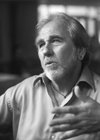 time a drug is introduced into the body to correct function A, it inevitably throws off function B, C or D.” – Bruce Lipton, author of “The Biology of Belief”
time a drug is introduced into the body to correct function A, it inevitably throws off function B, C or D.” – Bruce Lipton, author of “The Biology of Belief”
HERE ARE SOME OTHER QUOTES FROM THROUGHOUT HISTORY ABOUT PHARMACEUTICAL DRUGS:
“Medicines are of subordinate importance because of their very nature they can only work symptomatically.” – Hans Kusche, M.D.
 “If all the medicine in the world were thrown into the sea, it would be bad for the fish and good for humanity” – O.W. Holmes, (Prof. of Med. Harvard University)
“If all the medicine in the world were thrown into the sea, it would be bad for the fish and good for humanity” – O.W. Holmes, (Prof. of Med. Harvard University)
“Every drug increases and complicates the patients condition.” – Robert Henderson, M.D.
“Doctors give drugs of which they know little, into bodies, of which they know less, for Diseases of which they know nothing at all.” – Voltaire
“Drugs never cure disease. They merely hush the voice of nature’s protest, and pull down the danger signals she erects along the pathway of transgression. Any poison taken into the system has to be reckoned with later on even though it palliates present symptoms. Pain may disappear, but the patient is left in a worse condition, though unconscious of it at the time.” – Daniel. H. Kress, M.D.
“It’s supposed to be a secret, but I’ll tell you anyway. We doctors do nothing. We only help and encourage the doctor  within.” – Albert Schweitzer, M.D.
within.” – Albert Schweitzer, M.D.
“The greatest part of all chronic disease is created by the suppression of acute disease by drug poisoning.” – Henry Lindlahr, M.D.
“Every educated physician knows that most diseases are not appreciably helped by medicine.” – Richard C. Cabot, M.D. 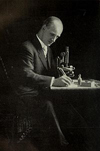 (Mass. Gen. Hospital)
(Mass. Gen. Hospital)
“The physician should not treat the disease but the patient who is suffering from it.” – Maimonides
“Medicine is only palliative, for back of disease lies the cause, and this cause no drug can reach.” – Wier Mitchel, M.D.
“Medical practice has neither philosophy nor common sense to recommend it. In sickness the body is already loaded with impurities. By taking drug – medicines more impurities are added, thereby the case is further embarrassed and harder to cure.” – Elmer Lee, M.D., Past Vice President, Academy of Medicine.
“The doctor of the future will no longer treat the human frame with drugs, but rather will Cure and prevent disease with nutrition.” – Thomas Edison
 “The necessity of teaching mankind not to take drugs and medicines, is a duty incumbent upon all who know their uncertainty and injurious effects; and the time is not far distant when the drug system will be abandoned.” – Charles Armbruster, M. D.
“The necessity of teaching mankind not to take drugs and medicines, is a duty incumbent upon all who know their uncertainty and injurious effects; and the time is not far distant when the drug system will be abandoned.” – Charles Armbruster, M. D.
“We must admit that we have never fought the homeopath on matters of principle. We fought them because they came into our community and got the business.” – Dr. J.N. McCormack
Permalink
October 6, 2014 at 4:31 pm · Filed under ARTICLES by other authors, RLS and Inflammation, Scientific Studies Linking RLS and Inflammation ·Tagged anti-inflammatory, aspartame, astaxanthin, caffeine, calcium, cayanne, chronic inflammation, curcumin, David Wimble, diet, dopamine, dopamine levels, Dr. Leonard Weinstock, Electromagnetic Fields, EMF, epigenetics, epigenome, ferritin, ferritin level, flora, food intolerance, gaba, ginger, glutamate, glutamine, gluten, Gut Microbiota, herbal remedies, herbs, Histamine Intolerance, histamines, homeopathy, inflammation, Inflammation and RLS, inflammation remedies, insomnia, iron, iron level, leaky gut, magnesium, microbiome, minerals, monosodium glutamate, msg, natural antihistamines, natural healing, natural medicine, nsaids, nutrution, omega 3, probiotics, restless arms, restless feet, restless leg syndrome, Restless Legs and Insomnia, restless legs cure, restless legs remedy, restless legs symptoms, restless legs syndrome, restless legs syndrome symptoms, rls, RLS and Epigenetics, RLS and Food Intolerance, RLS and Inflammation, RLS and Inflammation ·Tagged An ABSOLUTE Cure for RLS, rls cure, rls remedy, rls symptoms, salt, silent inflammation, sleep disorders, st. john's wort, sugar, systemic enyzmes, The Restless Legs Diet, vitamin b12, vitamin c, WED, willis-ekbom, willis-ekbom cure, willis-ekbom disease
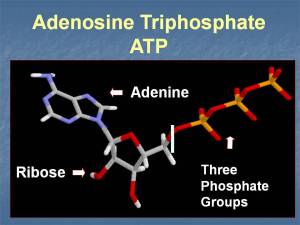 Whenever I run across something that has helped lessen a person’s RLS symptoms, whether it be a personal story or through a study, I know with 100% certainty that if I do a search on whatever it is they took to lessen their symptoms, that healing ingredient will have proven anti-inflammatory properties.
Whenever I run across something that has helped lessen a person’s RLS symptoms, whether it be a personal story or through a study, I know with 100% certainty that if I do a search on whatever it is they took to lessen their symptoms, that healing ingredient will have proven anti-inflammatory properties.
Such is the case with D-Ribose.
“D-Ribose is a naturally occurring five-carbon monosaccharide that is found in all living cells, and has anti-inflammatory effects in renal ischemia/reperfusion injury” (Ueki et al. 2013).
“D-ribose has anti-inflammatory activities and protects against damage mediated via inflammation.” from “D-ribose for energizing brain, autism and ADD/ADHD” by Dr. Anil Minocha, Board certified in Internal Medicine, Gastroenterology and Nutrition
I ran across a RLS study that was done in 2008 that showed great promise in a father and son with Restless Legs that were both given D-ribose.
I am going to post the results of the study followed by some basic information about what D-ribose is.
I realize in the great theater of science that this study doesn’t prove anything. However, to someone still suffering from RLS that is trying to find the slightest glimmer of hope, this is yet more evidence shining its light on the DIRECT LINK between RLS and INFLAMMATION.
STUDY: “D-ribose benefits restless legs syndrome.” (Shecterle et al. 2008).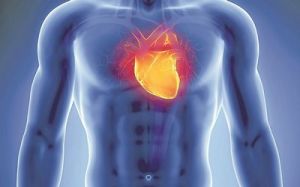
We report on two affected male individuals, a father and son, ages 71 and 47, from a family in which three generations carry the diagnosis. To evaluate any potential benefit of D-ribose in this condition, each individual orally consumed 5-g doses of D-ribose daily at different trial stages. Each stage lasted 3 weeks with a 2-week washout period between stages.
The initial stage involved a single 5 gm dose of D-ribose consumed at breakfast. Throughout the second stage, D-ribose was taken at breakfast and lunch. In the third stage, D-ribose was taken at all meals, breakfast, lunch, and dinner. Diaries by the subjects pertaining to their documentation and severity of restless legs syndrome symptoms was compiled. During the initial stage both men reported a general feeling of more energy and less fatigue, most notably after exercise, without any significant changes in their symptoms.
With the increase in the daily dose of D-ribose, in the second stage, their leg twitching and the feeling to move during the day was reduced for 1 subject, and rarely present in the other. Both still experienced the unpleasant sensations during the night.
However, during the final stage, a further increase in the daily dose of D-ribose eliminated their daily symptoms and the symptoms at night were of a lesser degree and had a later occurrence. Both men reported that D-ribose did not totally eliminate their discomfort, but the severity and onset of symptoms affecting their quality of life was substantially improved with D-ribose without any adverse reactions.
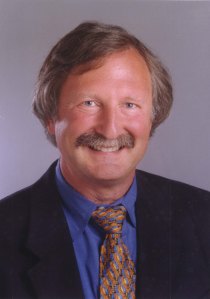 “D-Ribose–The Natural Body Energizer” from “Fatigued to Fantastic!” by Jacob Teitelbaum, M.D. (2007)
“D-Ribose–The Natural Body Energizer” from “Fatigued to Fantastic!” by Jacob Teitelbaum, M.D. (2007)
In looking at energy production, it helps to look at the “energy molecules” such as ATP, NADH, and FADH. These represent the energy currency in your body, and are like the paper that money is printed on. You can have all the fuel you want, but if it cannot be converted to these molecules, it is useless!
For years, I talked about the importance of B vitamins, which are a key component of these molecules. These helped to a degree, but it was clear that a key component was missing. In looking at the biochemistry of these energy molecules, they are also made of 2 other key components-adenine and ribose. Adenine is plentiful in the body and supplementing with adenine did not help CFS. We then turned our attention to Ribose. Ribose is made in your body in a slow, laborious process and cannot be found in food. We knew that CFS/FMS causes your body to dump other key energy molecules like acetyl-l-carnitine. We then found that the body did the same with Ribose, making it hard to get your furnaces working again even after the other problems were treated.
This was like one of those “Eureka!” moments where things came together. Not having Ribose would be like trying to build a fire without kindling—nothing would happen. We wondered if giving Ribose to people with CFS would jump-start their energy furnaces. The answer was a resounding yes!
Our recently published study (see the study abstract in Appendix B) showed an average 44.7% increase in energy after only 3 weeks (improvement began at 12 days) and an average overall improvement in quality of life of 30%. Two thirds of the CFS/FMS patients felt they had improved.19 Usually a 10% improvement for a single nutrient is considered excellent. A 44.7% increase left us amazed, and I am now recommending Ribose for all of my CFS/FMS patients, for athletes, and any one with pain, fatigue or heart problems. Ribose recently became available (over the counter) to physicians, and is one of the few natural products actually starting with physicians and then moving out into health food stores.
It is critical to use the proper dose for the first 3 weeks, which is 5 grams (5000 mg) three times a day. It can then be dropped to twice a day. I recommend the Corvalen form of ribose as it is the least expensive and highest quality and is packaged with a 5 gm dosing scoop in it. One 280 gm container will be enough to tell you if it will work. Corvalen M (which has ribose plus magnesium and malic acid) is also available, but if you are also taking the Energy Revitalization System vitamin powder (see chapter X), you are already getting the magnesium and malic acid, and the regular Corvalen is a better deal financially. Bioenergy, which makes Corvalen, also conducts almost all of the research on Ribose, knows the most about it, and has outstanding customer service in case you have any questions. Because of its importance, it’s worth looking at energy production and Ribose in greater detail. Having had the chance to explore the research and speak with a number of the researchers, below is what I’ve learned from them.
D-Ribose Accelerates Energy Recovery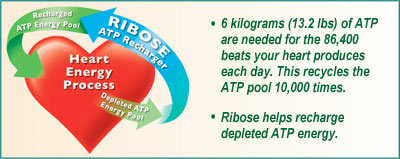
D-Ribose (which is what I am referring to when I say ribose) is a simple, five-carbon sugar (known as a pentose by biochemists) that is found naturally in our bodies. But ribose is not like any other sugar. Sugars we are all familiar with, such as table sugar (sucrose), corn sugar (glucose), milk sugar (lactose), honey (predominantly fructose), and others are used by the body as fuel. These sugars are consumed and, with the help of the oxygen we breathe, are “burned” by the body to recycle energy. Because they are used excessively, they can also be toxic, as we’ve discussed earlier. Ribose, on the other hand, is special. When we consume ribose, the body recognizes that it is different from other sugars and preserves it for the vital work of actually making the energy molecule that powers our hearts, muscles, brains, and every other tissue in the body.
A key molecule, called adenosine triphosphate (or ATP for short), is known as the energy currency of the cell because the amount of ATP we have in our tissues determines whether we will be fatigued, or will have the energy we need to live vital, active lives. Ribose provides the key building block of ATP, and the presence of ribose in the cell stimulates the metabolic pathway our bodies use to actually make this vital compound. If the cell does not have enough ribose, it cannot make ATP. So, when cells and tissues become energy starved, the availability of ribose is critical to energy recovery.
Normal, healthy heart and muscle tissue has the capacity to make all the ribose it needs. When normal tissue is stressed by overexertion, several days of rest will usually allow it to fully recover. The muscle may be sore during recovery, as we frequently see for the three or four days after a hard day of yard work or after a weekend pick up football game, but eventually energy levels will be restored and the soreness will disappear. But when the muscle is chronically stressed by disease or conditions that affect tissue energy metabolism, the cells and tissues simply cannot make enough ribose quickly enough to recover. Hearts and muscles just don’t have the metabolic machinery they need to make ribose very efficiently. The result is chronic, persistent pain, stiffness, soreness, and overwhelming fatigue that may never go away.
The Link between Ribose, Energy, and Fatigue
Clinical and scientific research has repeatedly shown that giving ribose to energy deficient hearts and muscles stimulates energy recovery. One important study involved healthy athletes participating in high-intensity, endurance exercise over the course of one week. After exercise the energy level in the athlete’s muscle was reduced by almost 30%. Giving 10-grams of ribose per day for three days following exercise restored muscle energy levels to normal, while treatment with placebo provided virtually no effect.20 This study clearly showed that ribose stimulated the energy recovery pathways in the body, helping the muscle rebuild its energy supply quickly and completely. Even after three days of rest, muscle that was not treated with ribose remained energy starved and fatigued.
Two very interesting studies in animals showed how dramatic the effect of ribose could be on energy recovery in fatigued muscle. These studies were conducted by Dr. Ron Terjung, one of the top muscle physiologists in the U.S. In their research, Dr. Terjung and his co-investigators found that ribose administration in fatigued muscle increased the rate of energy recovery by 340% to 430%, depending on which type of muscle was tested.21 He also found that even very small amounts of ribose had the effect of helping the muscle cell preserve energy, a process known as energy salvage, and the higher the ribose dose, the more dramatic the effect on energy preservation.22 Although this groundbreaking research was done in animals it was instrumental in defining the biochemistry and physiology associated with the use of ribose in overcoming heart and muscle fatigue. But most of us with CFS and FMS are neither top athletes nor animals, so the question remains, “How will ribose affect me?”
 Research in Ribose and CFS/FMS began with a case study that was published in the prestigious journal Pharmacotherapy in 2004.23 This case study told the story of a veterinary surgeon diagnosed with fibromyalgia. For months, this dedicated doctor found herself becoming more and more fatigued, with pain becoming so profound she was finally unable to stand during surgery. As a result, she was forced to all but give up the practice she loved.
Research in Ribose and CFS/FMS began with a case study that was published in the prestigious journal Pharmacotherapy in 2004.23 This case study told the story of a veterinary surgeon diagnosed with fibromyalgia. For months, this dedicated doctor found herself becoming more and more fatigued, with pain becoming so profound she was finally unable to stand during surgery. As a result, she was forced to all but give up the practice she loved.
Upon hearing that a clinical study on ribose in congestive heart failure was underway in the university where she worked, she asked if she could try the ribose to see if it might help her overcome the mind-numbing fatigue she experienced from her disease. After three weeks of ribose therapy she was back in the operating room, practicing normally with no muscle pain or stiffness, and without the fatigue that had kept her bedridden for many months.
Being a doctor, she was skeptical, not believing that a simple sugar could have such a dramatic effect on her condition. Within two weeks of stopping the ribose therapy, however, she was out of the operating room and back in bed. So, to again test the theory, she began ribose therapy a second time. The result was similar to her first experience, and she was back doing surgery in days. After yet a third round of stopping (with the return of symptoms) and starting (with the reduction of symptoms) the ribose therapy, she was convinced, and has been on ribose therapy since that time.
I found this report intriguing and decided to design the larger study in patients with fibromyalgia or chronic fatigue syndrome which I began to discuss earlier. Along with two research collaborators, I recently published a scientific paper describing the results of this research. The study we designed was intended to determine whether or not ribose would be effective in relieving the overwhelming fatigue, pain, soreness, and stiffness suffered by patients having this debilitating condition. Our study included 41 patients with a diagnosis of fibromyalgia or chronic fatigue syndrome who were given ribose at a dose of 5-grams three times per day for an average of three weeks. We found the ribose treatment led to significant improvement in energy levels, sleep patterns, mental clarity, pain intensity, and well being. Of the patients participating in the study, 65.7 % experienced significant improvement while on ribose, with an average increase in energy of 44.7% and overall well being of 30%- remarkable results from a single nutrient! 19 The only significant side effects were that 2 people felt too energized and hyper/anxious on the ribose. This is simply dealt with by lowering the dose and/or taking it with food.
To further validate these findings, we are currently conducting a much larger placebo controlled study, and hope to have the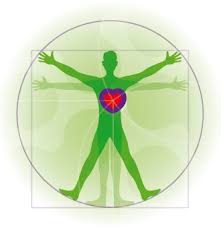 results published in the coming year. Interestingly, one of our study patients had an abnormal heart rhythm called atrial fibrillation. Ribose is outstanding in the treatment of heart disease as well, because it restores energy production in the heart muscle. Because of this, it was not surprising that this man’s atrial fibrillation also went away on the ribose and he was able to stop his heart medications as well! Because of its importance and the research showing marked heart muscle dysfunction (because of low energy) in CFS, let’s look at Ribose and the heart in more detail.
results published in the coming year. Interestingly, one of our study patients had an abnormal heart rhythm called atrial fibrillation. Ribose is outstanding in the treatment of heart disease as well, because it restores energy production in the heart muscle. Because of this, it was not surprising that this man’s atrial fibrillation also went away on the ribose and he was able to stop his heart medications as well! Because of its importance and the research showing marked heart muscle dysfunction (because of low energy) in CFS, let’s look at Ribose and the heart in more detail.
Permalink
October 4, 2014 at 6:40 pm · Filed under ARTICLES by other authors, RLS and Inflammation, Scientific Studies Linking RLS and Inflammation ·Tagged anti-inflammatories, anti-inflammatory, aspartame, astaxanthin, caffeine, calcium, cayanne, chronic inflammation, curcumin, David Wimble, diet, dopamine, dopamine levels, Dr. Leonard Weinstock, Electromagnetic Fields, EMF, epigenetics, epigenome, ferritin, ferritin level, flora, food intolerance, gaba, ginger, glutamate, glutamine, gluten, Gut Microbiota, herbal remedies, herbs, Histamine Intolerance, histamines, homeopathy, inflammation, Inflammation and RLS, inflammation remedies, insomnia, iron, iron level, leaky gut, magnesium, microbiome, minerals, monosodium glutamate, msg, natural antihistamines, natural healing, natural medicine, nsaids, nutrution, omega 3, probiotics, restless arms, restless feet, restless leg syndrome, Restless Legs and Insomnia, restless legs cure, restless legs remedy, restless legs symptoms, restless legs syndrome, restless legs syndrome symptoms, rls, RLS and Epigenetics, RLS and Food Intolerance, RLS and Inflammation, RLS and Inflammation ·Tagged An ABSOLUTE Cure for RLS, rls cure, rls remedy, rls symptoms, salt, silent inflammation, sleep disorders, st. john's wort, sugar, systemic enyzmes, The Restless Legs Diet, vitamin b12, vitamin c, WED, willis-ekbom, willis-ekbom cure, willis-ekbom disease
 Editor’s Note: Please understand that although I publish any hopeful information I can when it comes to natural remedies for RLS, I still stand firm in the belief that INFLAMMATION is the cause of RLS. So, a Vitamin D deficiency may be the cause (or may contribute) for some people, while others it may be a Vitamin B12 deficiency, for other an Iron deficiency, for others a Magnesium deficiency … and in most cases, just bad eating habits and stress.
Editor’s Note: Please understand that although I publish any hopeful information I can when it comes to natural remedies for RLS, I still stand firm in the belief that INFLAMMATION is the cause of RLS. So, a Vitamin D deficiency may be the cause (or may contribute) for some people, while others it may be a Vitamin B12 deficiency, for other an Iron deficiency, for others a Magnesium deficiency … and in most cases, just bad eating habits and stress.
They have yet to identify inflammation as being the real problem, and the ways that the inflammation is created, as being secondary. I don’t mean secondary as being ” less important,” what I mean is that you first have to identify the problem, admit that it exists, before the REAL healing can start. Once you have identified the problem, that your RLS is a symptom of the chronic inflammation in your body, then you can try and figure out how it got there, and how you can get rid of it.
As the saying goes “identifying the problem is HALF of the solution.”
However, instead of articles and studies that identify the real problem, what continually appears in the press are articles like the one below that attempts to identify the “ONE THING” that will set your legs free. They look for something we can BLAME it all on.
I totally agree with what Dr. Sircus stated in my previous post “no single medicine or nutritional agent has the power to both treat and prevent chronic inflammatory conditions.”
In other words, yes, a Vitamin D deficiency is inflammatory, and should be avoided at all costs. However, taking Vitamin D is not going to “cure” you if you are still leading an inflammatory lifestyle (including stress) or are consuming inflammatory foods.
Here is the article by Dr. Rosenburg:
“Within the past few years there have been several studies linking vitamin D to various sleep disorders. This connection is not surprising since vitamin D is involved in the regulation of calcium, phosphorous, and bone growth, as well as muscle function, immune regulation, and brain function.
There have also been studies linking vitamin D deficiency to sleepiness and enlarged tonsils in children, resulting in pediatric sleep apnea. Among the newer studies released, one of the most interesting studies is a new study, published August 2014 in the journal Sleep Breath titled The Effect of Vitamin D Supplements on the Severity of Restless Legs Syndrome, which links vitamin D deficiency to restless legs syndrome (RLS).
The study followed 12 subjects, all of whom were diagnosed with both primary RLS (meaning there was no other obvious cause) and vitamin D deficiency. All 12 patients were treated with vitamin D. After their levels returned to normal, they were reassessed. The severity of their RLS also significantly improved after treatment, causing the study authors to conclude that vitamin D deficiency may be associated with RLS.
This news comes on the heels of several other studies that have shown low levels of vitamin D in people with RLS.
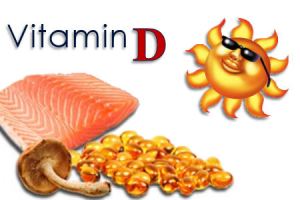 There are many places in which you can find vitamin D. One source is our skin, which can produce vitamin D upon exposure to sunlight. Vitamin D can also be found in certain foods including:
There are many places in which you can find vitamin D. One source is our skin, which can produce vitamin D upon exposure to sunlight. Vitamin D can also be found in certain foods including:
Milk
Cheese
Eggs
Oily fish (salmon, cod, and mackerel)
Low levels of vitamin D can be caused by dark skin pigmentation, limited sunlight exposure, pregnancy, abnormal intestinal absorption, and some medications.
As a result of these studies — and several other studies correlating vitamin D to restless legs syndrome, sleep apnea, excessive sleepiness, and nighttime muscle cramps – I intend to start checking my patient’s vitamin D levels more often. I am only sorry that I was not aware of this relationship before. Just a decade ago, most of us in sleep medicine would never have imagined that the same vitamin deficiency that can cause rickets and osteoporosis could be
involved in sleep disorders. Modern medicine never fails to amaze or humble me.”
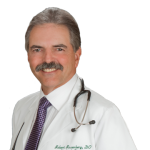 Dr. Robert Rosenberg first started practicing medicine in Chicago as an associate professor at the Chicago College of Osteopathic Medicine where he taught students, interns, and residents and attended to patients. In 1982, he moved to Arizona and opened a private practice focusing on internal medicine, pulmonary medicine and sleep medicine. He continued to teach in Arizona and California. In recent years, he’s limited his practice to sleep medicine, and he’s also started writing, blogging, and lecturing on sleep. His expertise as a sleep physician has been featured in various publications, including Newsweek and Oprah Magazine, and he also serves as a forensic sleep medical consultant for legal cases. Dr. Rosenberg sees patients at his private practices, the Sleep Disorders Centers of Prescott Valley and Flagstaff, both in northern Arizona. His first book is titled “Sleep Soundly Every Night, Feel Fantastic Every Day,”
Dr. Robert Rosenberg first started practicing medicine in Chicago as an associate professor at the Chicago College of Osteopathic Medicine where he taught students, interns, and residents and attended to patients. In 1982, he moved to Arizona and opened a private practice focusing on internal medicine, pulmonary medicine and sleep medicine. He continued to teach in Arizona and California. In recent years, he’s limited his practice to sleep medicine, and he’s also started writing, blogging, and lecturing on sleep. His expertise as a sleep physician has been featured in various publications, including Newsweek and Oprah Magazine, and he also serves as a forensic sleep medical consultant for legal cases. Dr. Rosenberg sees patients at his private practices, the Sleep Disorders Centers of Prescott Valley and Flagstaff, both in northern Arizona. His first book is titled “Sleep Soundly Every Night, Feel Fantastic Every Day,”
Permalink
October 3, 2014 at 5:49 pm · Filed under ARTICLES by other authors, RLS and Inflammation ·Tagged anti-inflammatories, anti-inflammatory, aspartame, astaxanthin, caffeine, calcium, cayanne, chronic inflammation, curcumin, David Wimble, diet, dopamine, dopamine levels, Dr. Leonard Weinstock, Electromagnetic Fields, EMF, epigenetics, epigenome, ferritin, ferritin level, flora, food intolerance, gaba, ginger, glutamate, glutamine, gluten, Gut Microbiota, herbal remedies, herbs, Histamine Intolerance, histamines, homeopathy, inflammation, Inflammation and RLS, inflammation remedies, insomnia, iron, iron level, leaky gut, magnesium, microbiome, minerals, monosodium glutamate, msg, natural antihistamines, natural healing, natural medicine, nsaids, nutrution, omega 3, probiotics, restless arms, restless feet, restless leg syndrome, Restless Legs and Insomnia, restless legs cure, restless legs remedy, restless legs symptoms, restless legs syndrome, restless legs syndrome symptoms, rls, RLS and Epigenetics, RLS and Food Intolerance, RLS and Inflammation, RLS and Inflammation ·Tagged An ABSOLUTE Cure for RLS, rls cure, rls remedy, rls symptoms, salt, silent inflammation, sleep disorders, st. john's wort, sugar, systemic enyzmes, The Restless Legs Diet, vitamin b12, vitamin c, WED, willis-ekbom, willis-ekbom cure, willis-ekbom disease
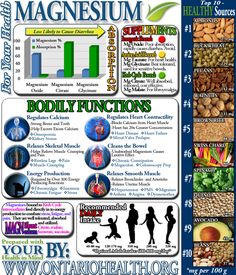 “There are many factors that trigger inflammation. They are found in both our internal and external environments and include excessive levels of the hormone insulin (insulin resistance), emotional stress, environmental toxins (heavy metals), free-radical damage, viral, bacterial, fungal other pathogenic infections, obesity, overconsumption of hydrogenated oils, periodontal disease, radiation exposure, smoking, spirochetes such as the Borrelia that causes Lyme disease, and certain pharmacological drugs.
“There are many factors that trigger inflammation. They are found in both our internal and external environments and include excessive levels of the hormone insulin (insulin resistance), emotional stress, environmental toxins (heavy metals), free-radical damage, viral, bacterial, fungal other pathogenic infections, obesity, overconsumption of hydrogenated oils, periodontal disease, radiation exposure, smoking, spirochetes such as the Borrelia that causes Lyme disease, and certain pharmacological drugs.
Approximately 12 million Americans have Restless Legs Syndrome, a sleep and movement disorder characterized by unpleasant (tingling, crawling, creeping and/or pulling) feelings in the legs, which cause an urge to move in order to relieve the symptoms. Magnesium supplements may be helpful for relieving Restless Legs Syndrome (RLS) and for treating insomnia.
However, in the final analysis there is no single medicine or nutritional agent that has the power to both treat and prevent chronic inflammatory conditions. 
Magnesium acts as a general cell tonic while it reduces inflammation and systemic stress. Equally it is important in overall energy (ATP) production, hormonal and enzyme production and function which all reflect powerfully on the process of inflammation.”
The above is an excerpt from an article by Dr. Mark Sircus Ac., OMD, DM. Dr. Sircus is a prolific writer and author of several medical and health-related books. Dr. Sircus’s methods are based on medical science and long years of clinical experience, not only his own but experiences of doctors from around the world.
http://drsircus.com/medicine/magnesium/inflammation-and-systemic-stress
Permalink
September 27, 2014 at 6:46 pm · Filed under The Restless Legs Diet ·Tagged anti-inflammatories, anti-inflammatory, aspartame, astaxanthin, caffeine, calcium, cayanne, chronic inflammation, curcumin, David Wimble, diet, dopamine, dopamine levels, Dr. Leonard Weinstock, Electromagnetic Fields, EMF, epigenetics, epigenome, ferritin, ferritin level, flora, food intolerance, gaba, ginger, glutamate, glutamine, gluten, Gut Microbiota, herbal remedies, herbs, Histamine Intolerance, histamines, homeopathy, inflammation, Inflammation and RLS, inflammation remedies, insomnia, iron, iron level, leaky gut, magnesium, microbiome, minerals, monosodium glutamate, msg, natural antihistamines, natural healing, natural medicine, nsaids, nutrution, omega 3, probiotics, restless arms, restless feet, restless leg syndrome, Restless Legs and Insomnia, restless legs cure, restless legs remedy, restless legs symptoms, restless legs syndrome, restless legs syndrome symptoms, rls, RLS and Epigenetics, RLS and Food Intolerance, RLS and Inflammation, RLS and Inflammation ·Tagged An ABSOLUTE Cure for RLS, rls cure, rls remedy, rls symptoms, salt, silent inflammation, sleep disorders, st. john's wort, sugar, systemic enyzmes, The Restless Legs Diet, vitamin b12, vitamin c, WED, willis-ekbom, willis-ekbom cure, willis-ekbom disease
 Unlike drugs, nutrients do not have rapid effects. There’s NO QUICK fix!
Unlike drugs, nutrients do not have rapid effects. There’s NO QUICK fix!
The business of nutrition is to BUILD a better body. That has to wait on Nature to turn over body cells. A blood cell lasts 60 to 120 days. In 3 to 4 months your whole blood supply is completely replaced. In 6 months almost all the proteins in your bones die and are replaced … even the DNA OF YOUR GENES. In a year all your bones and even the enamel of your teeth is replaced.
This time curve is well illustrated by the course of deficiency diseases. If I remove the Vitamin C from your diet, within 4 weeks your blood Vitamin C will drop to zero. But, you will see no symptoms of disease at 4 weeks. You have to WAIT until enough of the HEALTHY cells have been REPLACED by unhealthy cells. It is ANOTHER 12 weeks before the symptoms of scurvy start to ravage your body.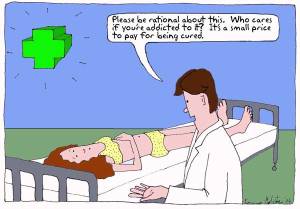
Think of it this way, If you take a neglected house plant and start feeding and watering it, the leaves may PERK UP a BIT from the improved nutrition. But you have to wait for the OLD leaves to die off and NEW leaves to grow before you get a really HEALTHY plant. It is the SAME with the human body. When you start feeding it better, you have to wait on your body to grow NEW improved cells.
To understand the difference between drugs and herbs, let’s focus on how they work. Pharmaceutical drugs are highly purified, potently concentrated chemicals which act by blocking processes of the body. This often gets rid of the symptoms but may create undesired side effects. Anti-congestants will clear your nose, but cause drowsiness. Prolonged use of non-steroids temporarily ease your arthritis pain, but may adversely affect your liver.
 When we drink a tea or take a tincture of an herb, we are taking in the whole plant, with thousands of compounds. Although plants contain unique ingredients which give them specific effects, it is the COMBINATION of all these compounds that accounts for a plant’s effectiveness and safety. The concept that a plant is more than the sum total of all its parts is known as synergy. Synergy means compounds work TOGETHER to boost the power of plants and offset actions of unsafe constituents.
When we drink a tea or take a tincture of an herb, we are taking in the whole plant, with thousands of compounds. Although plants contain unique ingredients which give them specific effects, it is the COMBINATION of all these compounds that accounts for a plant’s effectiveness and safety. The concept that a plant is more than the sum total of all its parts is known as synergy. Synergy means compounds work TOGETHER to boost the power of plants and offset actions of unsafe constituents.
In their wholeness, plants work by effecting favorable changes in our physiology, allowing the body to return to a balanced state. In the holistic tradition, the body knows how to heal itself and will do so given proper assistance. Herbs are our allies in this process.101
In order to get results from herbal treatments it is often necessary to be on a course for several months, especially for serious and/or long-standing problems. Herbs work slowly restoring the body back to balance. There is no magic quick fix with natural medicine because it has to work at such deep levels within the body systems.
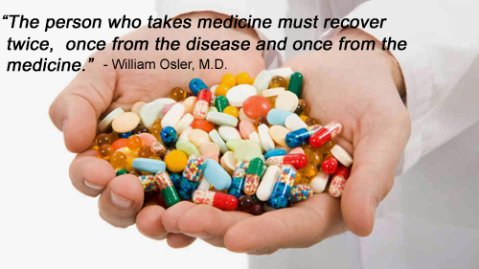
SOURCES:
Alternative Medicine for Pets – Nerve damage by Silva Mirovics All Experts en.allexperts.com
How long does it take to heal? by Dr. M. Colgan http://www.diseaseeducation.com
The Whole Herb: Natural Drugs to Help the Body Heal Itself by Mary Jo Ruggieri http://www.columbuspolarity.com
Permalink
September 25, 2014 at 1:54 pm · Filed under ARTICLES by other authors, RLS and Inflammation ·Tagged anti-inflammatories, anti-inflammatory, aspartame, astaxanthin, caffeine, calcium, cayanne, chronic inflammation, curcumin, David Wimble, diet, dopamine, dopamine levels, Dr. Leonard Weinstock, Electromagnetic Fields, EMF, epigenetics, epigenome, ferritin, ferritin level, flora, food intolerance, gaba, ginger, glutamate, glutamine, gluten, Gut Microbiota, herbal remedies, herbs, Histamine Intolerance, histamines, homeopathy, inflammation, Inflammation and RLS, inflammation remedies, insomnia, iron, iron level, leaky gut, magnesium, microbiome, minerals, monosodium glutamate, msg, natural antihistamines, natural healing, natural medicine, nsaids, nutrution, omega 3, probiotics, restless arms, restless feet, restless leg syndrome, Restless Legs and Insomnia, restless legs cure, restless legs remedy, restless legs symptoms, restless legs syndrome, restless legs syndrome symptoms, rls, RLS and Epigenetics, RLS and Food Intolerance, RLS and Inflammation, RLS and Inflammation ·Tagged An ABSOLUTE Cure for RLS, rls cure, rls remedy, rls symptoms, salt, silent inflammation, sleep disorders, st. john's wort, sugar, systemic enyzmes, The Restless Legs Diet, vitamin b12, vitamin c, WED, willis-ekbom, willis-ekbom cure, willis-ekbom disease
 The cause of disease in our bodies is often silent. It creeps up on us slowly over time, like a smoldering fire that burns unnoticed till one day we wake up with an illness.
The cause of disease in our bodies is often silent. It creeps up on us slowly over time, like a smoldering fire that burns unnoticed till one day we wake up with an illness.
This is true for most chronic diseases like diabetes, high blood pressure, high cholesterol or heart disease. It also true for many other diseases like autoimmune conditions, hormonal imbalances, gastrointestinal diseases, and just about anything that is ends in “itis.”
Medical research has begun to ask questions about what the common underlying causes are of all these problems that create disease in our bodies. And research is looking into what types of tests we can use to find them and measure them.
Chronic inflammation, more accurately known as low-grade or systemic inflammation, is becoming a topic of research to answer questions about the common underlying cause of disease.
Chronic inflammation is different from the normal or acute, or short-lived, inflammation that occurs when we have a bruise or cut. In acute inflammation our bodies find the bruise or cut, send chemicals into the area, heal the problem, and then our body goes back to its normal processing.
Chronic inflammation is different because the body is not able to shut off the immune response and it continues at a low level, like a fire that is at a smoldering burn for much too long. Over time, this smoldering flame can ignite into a major problem or chronic disease.
This is when you go to the doctor and you are given the diagnoses of diabetes or high cholesterol, when you thought 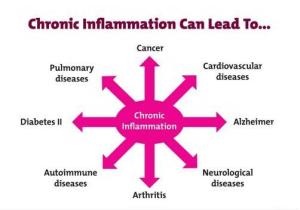 everything was fine. Perhaps you were not feeling well or you have been having symptoms, but you still are surprised by your diagnosis and you don’t know how to solve this unexpected problem.
everything was fine. Perhaps you were not feeling well or you have been having symptoms, but you still are surprised by your diagnosis and you don’t know how to solve this unexpected problem.
There is no standard treatment for chronic inflammation at this time. There does seem to be a benefit to modifying your eating habits toward an anti-inflammatory diet. This would include eating fruits and vegetables, healthy fats, small portions of nuts, eating fish and consuming very little red meat.
One of the markers for chronic inflammation that can be measured by a simple blood test is homocysteine.
This is often measured only in people that have a history or heart disease, but you can request it as part of your normal check up from your doctor.
A normal homocysteine level is found between 4.4 and 10.8 micromoles per liter of blood.
If yours is higher, this can be a marker of inflammation and can contribute to a host of diseases beyond heart disease. There is an increased risk of Alzheimer’s disease for people with high homocysteine levels, as well.
 Living healthy is more than just a cool thing to do. It is a way of life that has positive impact because you don’t end up getting sick over time.
Living healthy is more than just a cool thing to do. It is a way of life that has positive impact because you don’t end up getting sick over time.
Dr. Daemon Jones is a diabetes reversal, hormones, metabolism and weight loss expert. She is a doctor of Naturopathic Medicine based out of the Washington Metropolitan area. http://www.healthydaes.com
Permalink






































